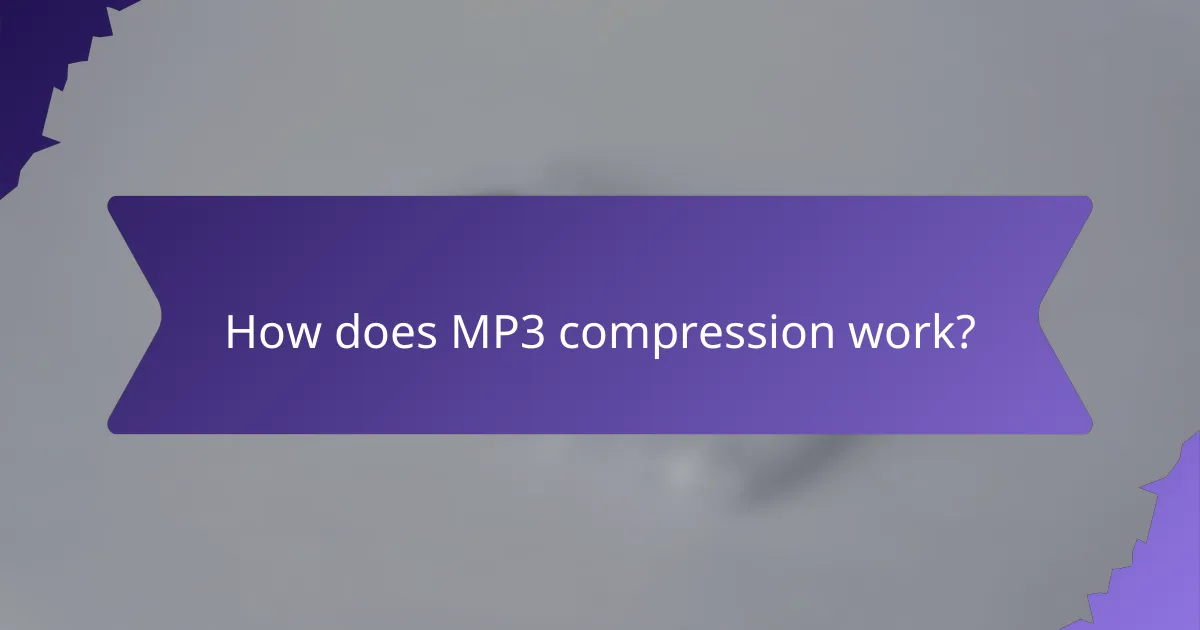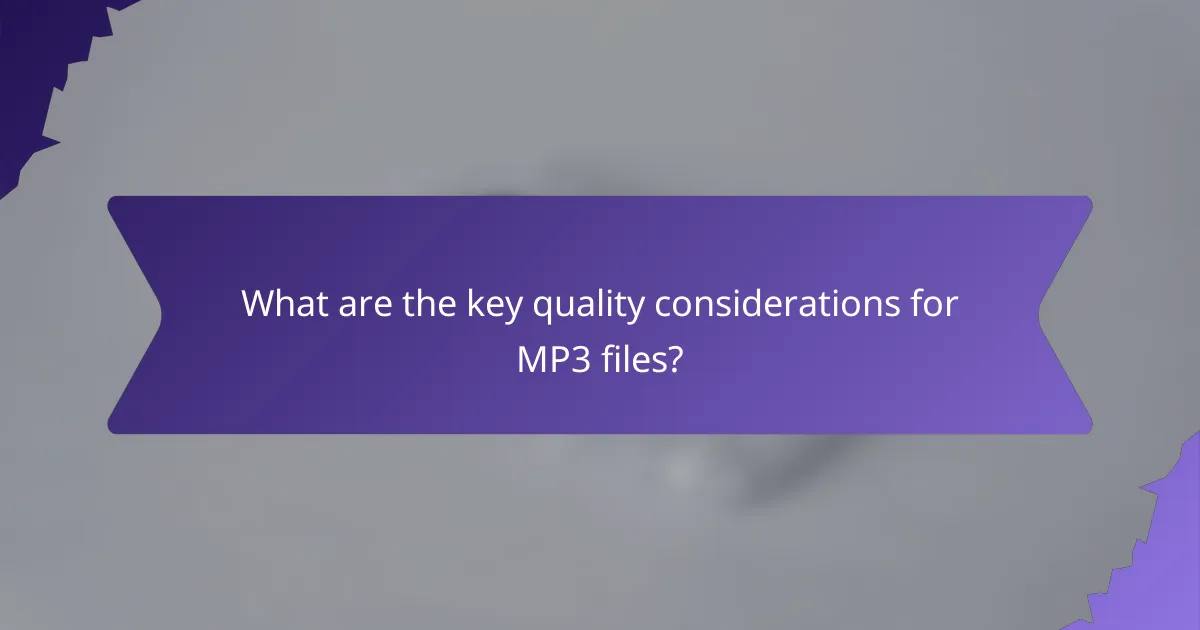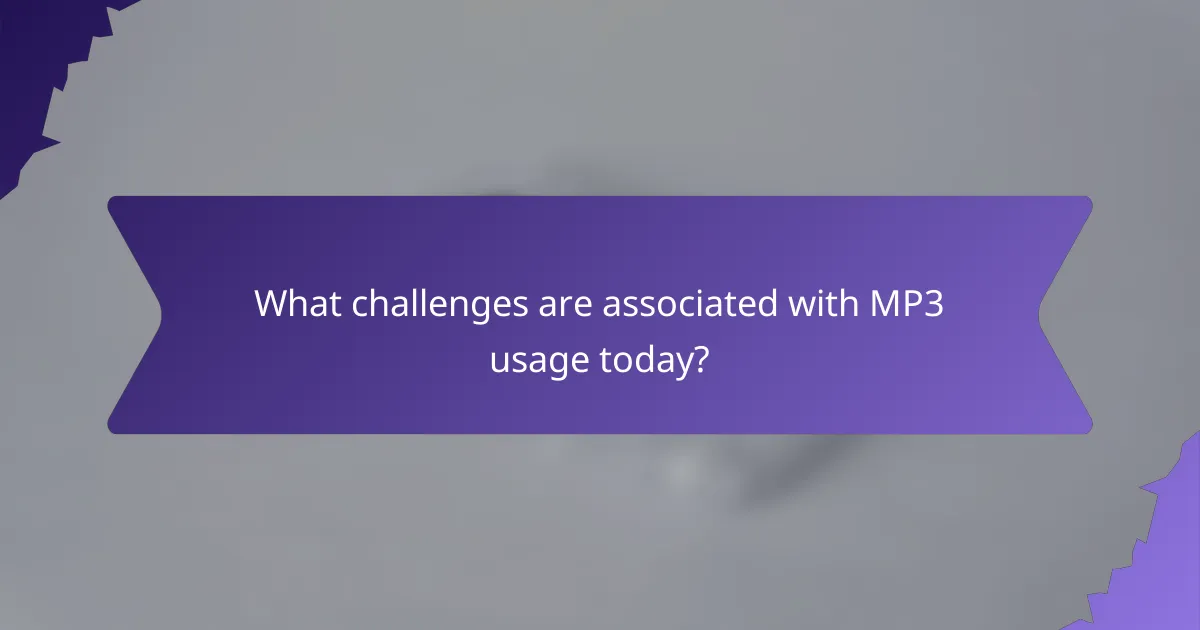The MP3 format revolutionized music consumption by enabling efficient storage and streaming. It compresses audio while maintaining quality, impacting how consumers access music. Key considerations include bitrate and compression artifacts, influencing sound fidelity. As technology evolves, MP3 faces challenges from higher-quality formats and changing listening habits.

How does MP3 compression work?
MP3 compression reduces file size while maintaining audio quality by removing inaudible frequencies. It uses perceptual coding to analyze sound and eliminate data that the human ear cannot perceive. This process allows for efficient storage and streaming of music, significantly impacting how consumers access and enjoy audio content. The average bitrate for MP3 files ranges from 128 kbps to 320 kbps, balancing quality and size. MP3’s widespread adoption has transformed music consumption, enabling portable devices and online streaming platforms.
What are the technical aspects of MP3 encoding?
MP3 encoding involves lossy compression techniques that reduce file size while maintaining acceptable audio quality. Key technical aspects include bit rate selection, psychoacoustic models, and encoding methods like Constant Bit Rate (CBR) and Variable Bit Rate (VBR).
Bit rate significantly affects audio quality and file size; common rates range from 128 kbps to 320 kbps. Psychoacoustic models analyze human hearing to eliminate inaudible sounds, optimizing compression. CBR provides consistent quality, while VBR adjusts the bit rate based on audio complexity, enhancing efficiency.
The impact of MP3 encoding on music consumption is profound, enabling portable music formats and digital distribution, reshaping how audiences access and enjoy music.
What is the impact of bit rate on audio quality?
Bit rate significantly affects audio quality; higher bit rates yield better sound fidelity. In MP3 format, common bit rates include 128 kbps, 192 kbps, and 320 kbps. For instance, 320 kbps provides near CD-quality sound, while 128 kbps may result in noticeable compression artifacts. Users often prioritize bit rate when selecting audio files for optimal listening experiences. As a result, understanding bit rate helps consumers make informed choices about music quality.
Which algorithms are used in MP3 compression?
MP3 compression primarily uses perceptual coding algorithms, notably the Modified Discrete Cosine Transform (MDCT) and psychoacoustic models. These techniques analyze audio signals to reduce file size while maintaining sound quality. The psychoacoustic model discards inaudible sounds, optimizing data storage. MDCT efficiently compresses frequency components, enhancing playback performance.

What are the key quality considerations for MP3 files?
Key quality considerations for MP3 files include bitrate, compression artifacts, and frequency response. Higher bitrates typically yield better sound quality, while lower bitrates can introduce noticeable artifacts. MP3 files usually range from 128 kbps to 320 kbps, with 320 kbps being the highest quality available. Additionally, the encoding method can affect the overall audio fidelity, influencing how well the file reproduces the original sound. Understanding these factors helps consumers choose MP3 files that meet their quality expectations.
How does MP3 quality compare to other audio formats?
MP3 quality often falls short compared to lossless formats like FLAC or WAV, which retain full audio fidelity. However, MP3’s compression allows for smaller file sizes, making it more convenient for music consumption. While MP3 typically offers bit rates ranging from 128 to 320 kbps, lossless formats provide a richer listening experience without sacrificing detail. As a result, MP3 remains popular for casual listening despite its limitations in quality compared to other audio formats.
What factors influence perceived sound quality in MP3s?
Perceived sound quality in MP3s is influenced by bitrate, compression algorithms, and playback equipment. Higher bitrates generally yield better sound quality, while advanced compression algorithms can preserve audio fidelity. Additionally, the quality of headphones or speakers significantly impacts the listening experience.
Why do some listeners prefer lossless formats over MP3?
Listeners prefer lossless formats over MP3 for superior audio quality and fidelity. Lossless formats retain all original sound data, providing a richer listening experience. In contrast, MP3 compression reduces audio quality, sacrificing detail for smaller file sizes. Audiophiles value lossless formats for their ability to reproduce music as intended by artists. Additionally, lossless formats support high-resolution audio, appealing to those who prioritize sound clarity. Overall, the preference stems from a desire for authenticity in music consumption.

How has the MP3 format influenced music consumption trends?
The MP3 format significantly transformed music consumption by enabling easy digital distribution and portability. Its compression technology reduced file sizes while maintaining acceptable audio quality, making music accessible on various devices. As a result, users shifted from physical media to digital platforms, leading to the rise of streaming services. The convenience of MP3s has influenced listening habits, promoting on-demand access and personalized playlists. This shift marked a pivotal change in how music is produced, marketed, and consumed globally.
What role does MP3 play in digital music distribution?
MP3 plays a crucial role in digital music distribution by enabling efficient compression, which significantly reduces file sizes without greatly compromising audio quality. This format has transformed music consumption by making it easier to store and share music across various platforms. The widespread adoption of MP3 has facilitated the rise of digital music services, allowing consumers to access vast libraries of songs instantly. Additionally, the MP3 format’s compatibility with numerous devices has further enhanced its impact, ensuring seamless playback across smartphones, computers, and portable media players.
How do streaming services utilize MP3 technology?
Streaming services leverage MP3 technology to compress audio files, ensuring efficient storage and fast transmission. This format balances sound quality with file size, making it ideal for online music consumption. MP3’s ability to reduce file sizes without significantly compromising audio quality has transformed how users access and enjoy music. As a result, millions of tracks are readily available for streaming, catering to diverse listener preferences.
Which demographic groups are most impacted by MP3 consumption?
Younger audiences, particularly those aged 18 to 34, are most impacted by MP3 consumption. This demographic frequently engages with digital music platforms, influencing their listening habits and preferences. Additionally, urban populations show higher MP3 usage due to better access to technology and internet services. As a result, MP3 format has transformed music consumption patterns, especially among tech-savvy individuals.

What challenges are associated with MP3 usage today?
MP3 usage today faces challenges related to sound quality, copyright issues, and evolving technology. The compression of MP3 files often sacrifices audio fidelity, leading audiophiles to prefer higher-quality formats. Additionally, copyright restrictions complicate distribution and access to music. As streaming services rise, the relevance of MP3s diminishes, impacting consumer behavior and industry standards.
How do copyright issues affect MP3 distribution?
Copyright issues significantly hinder MP3 distribution by restricting access and sharing of music files. These legal constraints impact artists, producers, and consumers by limiting the availability of music and encouraging unauthorized sharing. As a result, many platforms face legal challenges, affecting their business models and the overall music consumption landscape. The unique attribute of copyright laws varies by region, leading to inconsistent enforcement and user experiences across different markets.
What are the limitations of MP3 in the modern audio landscape?
MP3 has several limitations in the modern audio landscape, primarily related to sound quality and flexibility. Its lossy compression reduces audio fidelity, leading to a loss of detail compared to lossless formats. Additionally, MP3 does not support high-resolution audio, which is increasingly preferred by audiophiles. The format also lacks advanced metadata capabilities, limiting the information that can accompany tracks. As streaming services evolve, the demand for higher quality audio formats challenges MP3’s dominance in music consumption.

What are the future prospects for the MP3 format?
The future prospects for the MP3 format appear limited due to the rise of higher-quality audio formats. As streaming services prioritize sound fidelity, formats like AAC and FLAC are gaining popularity. MP3’s compression efficiency remains a strength, but its lower audio quality is becoming a drawback. Additionally, emerging technologies such as spatial audio may further diminish MP3’s relevance. While it will retain a nostalgic value, the shift towards superior audio experiences indicates a decline in its usage.
How are advancements in technology altering MP3’s relevance?
Advancements in technology are diminishing the MP3 format’s relevance by introducing superior audio formats. High-resolution audio and lossless compression options, such as FLAC and ALAC, offer enhanced sound quality. Streaming services prioritize these formats, allowing users access to vast music libraries without storage limitations. As a result, consumer preferences are shifting towards higher fidelity experiences, challenging the MP3’s dominance.
Which emerging formats could replace MP3?
Emerging formats that could replace MP3 include AAC, OGG Vorbis, and FLAC. Each offers advantages in compression and sound quality. AAC provides better quality at lower bit rates, making it popular for streaming services. OGG Vorbis is open-source and offers high-quality audio without licensing fees. FLAC, while larger in file size, preserves audio fidelity, appealing to audiophiles. These formats reflect advancements in music consumption and technology.
What innovations are being developed to enhance MP3 quality?
Innovations enhancing MP3 quality include advanced codecs, artificial intelligence, and lossless compression techniques. New codecs like AAC and Opus provide better sound quality at lower bitrates. AI-driven tools analyze audio to optimize playback, improving clarity and detail. Lossless compression formats, such as ALAC and FLAC, offer high fidelity without sacrificing quality, appealing to audiophiles. These developments significantly impact how music is consumed, prioritizing both quality and accessibility.
How can users optimize their MP3 collections for better playback?
Users can optimize their MP3 collections by using high-quality encoding settings and organizing files effectively. Start by selecting a bitrate of at least 192 kbps for better sound quality. Use consistent metadata to ensure easy searching and sorting. Regularly eliminate duplicates to save space and enhance organization. Consider using lossless formats for archiving important tracks, as they preserve original quality. Lastly, utilize music management software to streamline playback and create playlists efficiently.